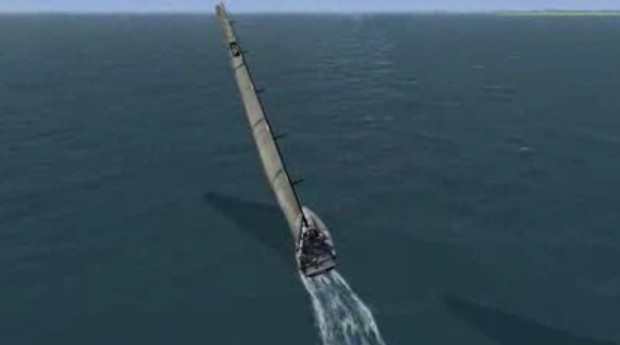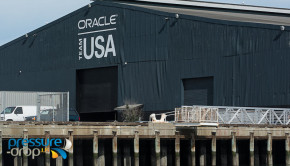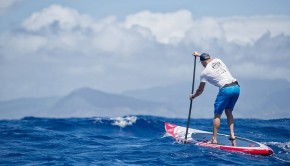Win-Win For “Old” Race Boats
Published on July 17th, 2010
(July 13, 2010) Courtesy of Seahorse, widely regarded as the pre-eminent performance sailing publication in the world, American correspondent Dobbs Davis sheds some light on the boat donation tactic. Originally published in the July 2010 issue of Seahorse:
So, you’ve got your 65-foot high-tech carbon offshore racing yacht that you’ve had modest success with over the last four years, but it’s getting just a little long in the tooth as the new designs are starting to leap-frog you around the track. You’re told their latest rig and appendage innovations just don’t work on your boat, as the retro-fit would be costly and add too much weight in the structure to be competitive at the top level of the game.
So, you’ve started talking with a couple of designers, soliciting ideas about a new design, but then the thought occurs: what to do with your (now) old boat? Of course you’ll list it with one of the reputable brokers you know, but it could take years to move even though it was built and maintained impeccably, has an impressive race record, and can still be reasonably competitive in the right hands (not to mention all those sails…). While your plans to do a new boat may not be contingent on the sale of the old one, you’d like to see it move into new hands without letting it go at such a ridiculous price to undermine the value of others out there in the market.
One option available to US owners faced with this predicament is donation. Yes, on the surface this doesn’t sound any different than the pejorative chuckle “he gave it away,” but in fact there is an excellent system that if the circumstances are right creates a win-win situation for all parties involved.
The intricacies of the US tax code are well-known and keep an entire industry flourishing here, but there is a provision which recognizes the charitable donation of an asset of substantial value to a non-profit foundation as eligible for a tax deduction. The rules are strict, and not everyone can benefit by such a move, but basically if the organization or foundation has the proper tax code status as a charity, and can keep and use this asset for a period of at least three years, then it passes muster with the IRS. This last provision is a key element to weed out donations made to organizations who then set up dodgy deals, like taking on ownership on paper then leasing it back to the original owner on a handshake whilst the original owner realizes the tax break.
“These donations are not for everyone,” cautions Bill Jenkins of Thoroughbred Yacht Sales. “The parties involved have to clear on the rules, and it’s important they don’t get abused.” Jenkins has brokered numerous donation deals, but works only with organizations which meet the criteria.
When done properly, however, this can be a win-win deal for all concerned: for the brokers who set up the deal and are knowledgeable about how to execute this so it will work (there are only a few, by the way); for the boat owner who wants to move the boat off his own books without accepting a sometimes embarrassing market price, and who legitimately wants to see his boat go to a suitable new home whilst realizing a modest tax break; and to the new owners, who have a programme where their new boat can be used for training and possibly for charters to generate some income to help keep the boat in good maintenance for its tenure with them, and then represent a good value for when its turned loose on the open market after a few years, with hopefully a profit realized to help support the foundation.
The sport also benefits, since the boat is still participating in races and regattas rather than just languishing on the hard with a For Sale sign draped over her bow.
This scheme helps support several elite offshore sailing programmes affiliated with universities and service academies that have the facilities and training regimens to keep up a modern offshore racing yachts. Examples include the Massachusetts Maritime Academy, the US Coast Guard Academy in New London, the US Merchant Marine Academy at Kings Point, the US Naval Academy in Annapolis, and Orange Coast College and Cal Maritime Academy in California. Each of these have been able to put their students on modern racing yachts to help fulfill their mission to train them in a competitive offshore environment to attain important leadership skills they’ll need in their careers.
Some recent examples of yachts donated in the last few years include the R/P 81 Carerra given to Mass Maritime; the Dubois 90 Genuine Risk, the R/P STP 65 Moneypenny, and the J/V 66 Bella Mente given to Kings Point; and the R/P 65 Zaraffa given to the US Naval Academy.
As a veteran of a few AC programmes sailed with Dennis Conner and the Stars and Stripes team, as well as numerous other offshore projects, Kings Point offshore programme manager Ralf Steitz knows the boats and the game well, and is grateful to have these donations. He also out that besides these high-profile platforms, Kings Point is grateful to take on boats as small as J/24’s for use in their program.
“It is fantastic to have access to this latest technology for our students,” says Steitz, “they would struggle to find an opportunity to have this by any other means.” Kings Point also has a few Farr 40’s that are campaigned in regional events, and as such he’s also been a convenient repository for old Farr 40 sails over the years.
Steitz says the donation program has been phenomenal for them in achieving their goals of not only getting the students out to sea in a competitive environment, but also providing them some real-time training in complex mechanical, electrical, and hydraulic systems found on modern race boats (and which, as we know, are not always trouble-free). He feels this is a good analogy to what they will encounter in the world of commercial shipping.
But there is a drawback to maintaining race horses: maintenance costs. “Our problem is maintenance, particularly with the really high-tech boats, as our resources get very stretched to do repairs if things break.” Steitz knows these boats need proper care to be used and maintain their value for eventual sale, so he also employs experienced boat captains to help with the maintenance and delivery of boats when and if they go to sea with the cadets and sponsors who volunteer their expertise while racing. The upcoming Newport-Bermuda Race has three of his big boats entered, so it’s been a busy spring season whilst still trying to be economical with his limited funds.
For example, rather than stage his boats in expensive Newport or Portsmouth, which is admittedly the center of the action for the East Coast, he keeps them in a new but little-known yard called Tidewater Marine in Baltimore harbor. Here, just metres away from huge naval transport ships in a busy commercial port, is a unique deep-water facility based in the Chesapeake which is new, clean, and 15 minutes from the train station and BWI airport where for the same travel time as going to Newport he can have his boats kept at a fraction of the price. For the few commuting trips the boat makes up to the events in Newport, he reckons it’s worth it.
Another example of a high-profile donated yacht is the US Naval Academy’s recent acquisition of John Kilroy’s B&C modified TP52 Samba Pa Ti. Renamed Invictus to coincide with the motto of the 2010 graduating class, this is one of the most successful boats of its size in recent years, a testament to the depth and talent of the Kilroy programme. The more senior and elite members of the Varsity Offshore Sailing Team will race this boat to Bermuda, no doubt arriving days ahead of their colleagues racing the academy’s normal training vessels, the 44-foot 13-ton Pedrick-designed Navy 44 sloops.
As a gesture of gratitude made towards Kilroy and his family, Invictus was re-christened at an impressive ceremony which invoked not only traditions of naval pomp and circumstance, but made entertaining and relevant with humour and personal anecdotes which revealed the strong connections between the academy culture and the offshore yachting community. The Academy’s Director of Navy Sailing Commander Chris Thomassy said “We’re extremely grateful for this donation, it a continues a tradition started in 1947 that has kept Navy competitive in offshore sailing. The addition of a TP52 to our fleet ensures our program remains world-class, and provides us a significant platform for character and leadership development of future American naval officers.”









 We’ll keep your information safe.
We’ll keep your information safe.